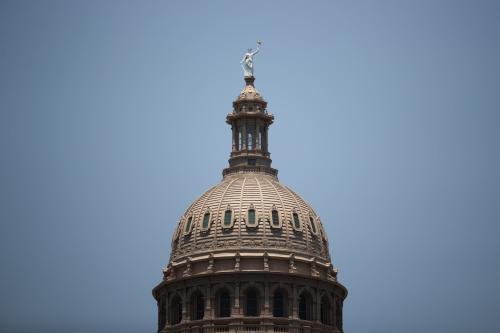The following testimony was given before the United States Commission on Civil Rights for the public briefing, “Civil Rights Implication of the Federal Use of Facial Recognition Technology,” on March 8, 2024. Watch the full briefing here.
Chair Garza, Vice Chair Bourse, and distinguished members of the United States Commission on Civil Rights, thank you for the invitation to testify on the important issue on the federal use of facial recognition technology (FRT). I am Nicol Turner Lee, a senior fellow in Governance Studies, and director of the Center for Technology Innovation at the Brookings Institution. With a history of over 100 years, Brookings is committed to evidence-based, nonpartisan research in a range of focus areas. My research expertise encompasses data collection and analysis around regulatory and legislative policies that govern telecommunications and high-tech industries, along with the impacts of digital exclusion, artificial intelligence, and machine learning algorithms on vulnerable populations. My forthcoming book, “Digitally Invisible: How the Internet Is Creating the New Underclass” will be published by Brookings Press later this summer.
I have spent the last few months as a member of the National Academies’ appointed research commission on the use of facial recognition, which was sponsored by the United States Department of Homeland Security (DHS, and the Federal Bureau of Investigations (FBI). The committee’s final report, titled “Facial Recognition Technology: Current Capabilities, Future Prospects, and Governance,” was published in January 2024 and offers a series of technical explanations, challenges, and recommendations at a time when facial recognition is increasingly being used in law enforcement investigations.1 As expected, concerns around equity, privacy, and the protection of existing civil rights emerged as critical themes in the report, as well as the need to think about future use cases of facial recognition by federal agencies and other police entities, including Customs and Border Patrol.
In my testimony, I want to reinforce many of the recommendations of that report, particularly those that speak to reasonable and equitable standards when it comes to facial recognition use, and specific calls to federal legislators to consider the risks, outcomes, and best practices that certify the use of the technology and offer greater transparency. I also propose in this statement that the federal government ‘lead by example’ by having reasonable requirements for procuring and using such technology and doing so in a way that respects the data privacy of individuals and their communities. Finally, when individuals and their families are harmed or have had their rights breached by FRT, the government must enable, either through legislation or the actions of State Attorneys General, some form of remuneration and/or appeal for affected individuals to recover from the resulting reputational and financial consequences of FRT, especially when violations are made under the direction of the government when it is designing, deploying, licensing, and/or distributing AI and more specific algorithmic models that lead to potentially irreversible harms.
The federal government, which has authority and oversight over massive amounts of public data, must act both ethically and responsibly in its use of facial recognition. And it must do so in ways that either enact appropriate guardrails over FRT, or decide to not to use it all, especially when the equity stakes are high. I will close my testimony with suggested recommendations that the Commission can consider when evaluating how the government can act responsibly in FRT adoption and use.
Defining facial recognition technologies
Even before Eadweard Muybridge captured the first ever motion picture of a Black man riding a horse in 1887, the history of photography and the history of Black people in America have been intertwined.2 Pioneering Black photographers and abolitionists like Glenalvin Goodridge and James Pressley Ball sought to document the cruelties of slavery, and famed intellectual Frederick Douglass would become the most photographed American of the 19th century.3 Nonetheless, the history of photography’s technical development has often been a history of the erasure of Black people. Before the advent of digital technology, photography involved exposing photo-sensitive materials to light and then chemically processing those materials to develop an image. The degree of contrast in the resulting images was determined by the photographic techniques and the composition of the chemicals used in film processing. Initially, photography was only accessible to wealthy white families, so early photographs used stark contrast that could capture the appearances of people with light skin but left those with dark skin virtually indistinguishable. Photographic techniques that were able to document Black people at all were only invented to capture images of furniture and even horses with darker textures.4
Beginning in 1954, Kodak used Shirley Cards—images of a white Kodak employee named Shirley—to calibrate their film production.5 As color printing became more accessible, Kodak and other film manufacturers began sending these cards to print businesses, meaning that virtually every machine in the printing industry was specifically calibrated to render images of white women, resulting in poorly rendered images of Black people. In the 1950s and 1960s, Kodak largely ignored complaints from Black parents that their children were visually obscured in school photographs.6 The company only improved the ability of their film to capture darker hues in the 1970s, after lobbying from furniture makers and chocolate manufacturers,7 and Kodak did not produce a multiracial Shirley Card until the mid-90s.8 Although the digital photography technology now used in surveillance cameras worldwide works differently, similar problems persist, and photographic methods still perform poorly for people with darker-skinned complexions, and equipment failures, like low quality cameras or poorly-lit settings, contribute to poor quality images and, thus, false results for Black people in FRT systems.
Continue reading the full testimony
Watch the full testimony:
-
Footnotes
- National Academies, “News Release: Advances in Facial Recognition Technology Have Outpaced Laws, Regulations; New Report Recommends Federal Government Take Action on Privacy, Equity, and Civil Liberties Concerns,” January 17, 2024 https://www.nationalacademies.org/news/2024/01/advances-in-facial-recognition-technology-have-outpaced-laws-regulations-new-report-recommends-federal-government-take-action-on-privacy-equity-and-civil-liberties-concerns
- Samantha Hill, “How Black people in the 19th century used photography as a tool for social change,” The Conversation, February 26, 2021, https://theconversation.com/how-black-people-in-the-19th-century-used-photography-as-a-tool-for-social-change-154721
- Michel Martin, “Picture This: Frederick Douglass Was The Most Photographed Man Of His Time,” NPR, December 13, 2015 https://www.npr.org/2015/12/13/459593474/picture-this-frederick-douglass-was-the-most-photographed-man-of-his-time
- Damien Patrick Williams, “Fitting the description: historical and sociotechnical elements of facial recognition and anti-black surveillance,” Journal of Responsible Innovation, Vol. 7 No. S1, 2020 Mandalit del Barco, “How Kodak’s Shirley Cards Set Photography’s Skin-Tone Standard,” NPR, November 13, 2014, https://www.npr.org/2014/11/13/363517842/for-decades-kodak-s-shirley-cards-set-photography-s-skin-tone-standard
- Mandalit del Barco, “How Kodak’s Shirley Cards Set Photography’s Skin-Tone Standard,” NPR, November 13, 2014, https://www.npr.org/2014/11/13/363517842/for-decades-kodak-s-shirley-cards-set-photography-s-skin-tone-standard
- Ainissa Ramirez, “How 20th Century Camera Film Captured a Snapshot of American Bias,” Time, July 24, 2020, https://time.com/5871502/film-race-history/
- Sarah Lewis, “The Racial Bias Built into Photography,” The New York Times, April 25, 2019, https://www.nytimes.com/2019/04/25/lens/sarah-lewis-racial-bias-photography.html
- Mandalit del Barco, “How Kodak’s Shirley Cards Set Photography’s Skin-Tone Standard,” NPR, November 13, 2014, https://www.npr.org/2014/11/13/363517842/for-decades-kodak-s-shirley-cards-set-photography-s-skin-tone-standard
The Brookings Institution is committed to quality, independence, and impact.
We are supported by a diverse array of funders. In line with our values and policies, each Brookings publication represents the sole views of its author(s).







Commentary
TestimonyCreating equitable standards for federal use of facial recognition technology
March 12, 2024